|
As I approached the international border checkpoint at Jinghong I was made aware that another bunch of foreigners had just paddled through the previous day. It was a team of New Zealanders who had also been undertaking a first descent of the Mekong valley by mountain bike, foot and kayak. As far as I know their expedition and my own are the only two attempts to explore the entire Mekong valley since the failed French Mekong Expedition in 1866. I find it incredible that after well over a hundred years since the French were forced to cancel their expedition near Dali in Yunnan that the next two attempts are undertaken simultaneously!
I crossed into Laos and surprisingly was let in without so much as paying for the visa. The border guards just assumed that I was a straggler from the kiwi group and stamped me in on their permit. For the sake of simplicity I just went along with it.
I paddled down long sections of swirl rapids until I noticed that what originally appeared to be a stick
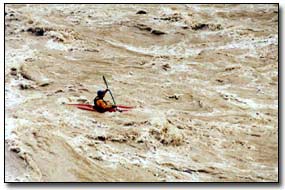 swaying in the current was actually a king cobra attempting to swim across the Mekong. Not one to miss a
photo opportunity I paddled as close as I safely could and began pulling my camera out. I know cobras were good swimmers as I had seen a few cross-creeks in the past but this guy was exceptional. I watched on as he was dragged into a succession of large whirlpools. He appeared almost completely un-phased as each whirlpool swirled him around until he would reach the apex and be sucked under but with a few quick whips of his tail he would fight his way free before slowly getting dragged into the next brooding whirlpool and so on.
swaying in the current was actually a king cobra attempting to swim across the Mekong. Not one to miss a
photo opportunity I paddled as close as I safely could and began pulling my camera out. I know cobras were good swimmers as I had seen a few cross-creeks in the past but this guy was exceptional. I watched on as he was dragged into a succession of large whirlpools. He appeared almost completely un-phased as each whirlpool swirled him around until he would reach the apex and be sucked under but with a few quick whips of his tail he would fight his way free before slowly getting dragged into the next brooding whirlpool and so on.
While getting my camera out I took my eye off the eight ball for a couple of moments and before I knew it I was inadvertently sucked into a whirlpool with him. He disappeared under the boat and there was a tense couple of seconds as I waited to see where he would pop up. I saw his tail flick just to the right of my kayak and he was gone again as the whirlpool spun me around. To be bitten by a king cobra in remote country such as this would almost certainly be fatal so I kept my elbows up high and my paddle at the ready to fend the snake off should he try to attack.
Eventually to my relief he popped up just 3 meters in front of me and as the whirlpool dissipated he decided to play dead. "Perfect chance to get that shot" I thought as I proceeded to get my camera out and start snapping. Just as I lined up for the second shot he turned and started swimming straight for me. I clicked again and quickly clenched the camera strap in my teeth before reaching for my paddle by which time he had his head up over the bow and was closing in fast. With instinctual speed I flicked him back into the water with my paddle blade and he disappeared again. This time there was a very tense couple of seconds as I waited, paddle at the ready imagining the cobra launching up out of the water for my throat. Fortunately when I next saw him he was heading for shore so I took another couple of snaps of him in flight. It was a pretty wild experience. I estimate that he swam over 2km during his crossing of the river.
I camped in a small rural Lao village that night and swapped stories by candle light with the bemused
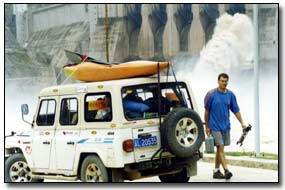 locals who could hardly believe that I had paddled down from Tibet nor that I could speak Lao to boot. Speaking Lao makes it all the more difficult to s ay no to the endless shots rice whisky that inevitably break out around dinner time. After more than 2 months of not drinking alcohol it wasn't long before I went from tipsy, to bullet proof to a mess. I can only assume that the boat race was arranged somewhere between the bullet proof and mess stages of the evening but the 4.30 am chorus of pigs and chickens under the stilted, thatch house was soon followed by the murmuring of a crowd of locals who gathered outside patiently waiting for the big event to start.
locals who could hardly believe that I had paddled down from Tibet nor that I could speak Lao to boot. Speaking Lao makes it all the more difficult to s ay no to the endless shots rice whisky that inevitably break out around dinner time. After more than 2 months of not drinking alcohol it wasn't long before I went from tipsy, to bullet proof to a mess. I can only assume that the boat race was arranged somewhere between the bullet proof and mess stages of the evening but the 4.30 am chorus of pigs and chickens under the stilted, thatch house was soon followed by the murmuring of a crowd of locals who gathered outside patiently waiting for the big event to start.
I opened my eyes to the sight of about 15 people who had been sitting there watching me sleep for god knows how long before crawling out of bed with a throbbing headache. After a breakfast of bamboo soup and sticky rice there was no getting out of it. I had to race 3 strapping young fishermen in a long sleek wooden pirogue. There's nothing Lao people love more than a good boat race and all 120 or so people from the village came down to watch their boys whoop the "falang" (Foreigner in Lao language). I must have been terribly drunk to agree to such a challenge. Their boat was twice as long as mine and about the same width. Over the 300-meter course the boys pulled away by about 20 meters and by the end of it I was trying my best no t to hurl breakfast into the river as the delighted crowd cheered their boys home. Never again! I promised myself.
The next day I bumped into the New Zealanders. They were a great bunch of people and we spent hours swapping stories and experiences from the upper Mekong. Like my trip their expedition had been plagued by unforeseen problems. They had spent 3 full weeks in Jinghong attempting to get their imported kayaks out of customs and sorting out p permits to cross by kayak into Laos. To their distress they were also forced to leave the Mekong Valley through much of the Tibetan section because the roads that they were told were bike-able through the area did not exist.
Eventually we bade farewell and I paddled on ahead to the Paradise Casino Resort, an obscurely located but pleasant resort among the dense forests of North West Myanmar. A friend had arranged a sponsored stay at the resort and after many weeks of camping, village stays and budget guesthouses it was a welcome change. Rice and 2-minute noodles were replaced with sushi and roast beef and with five or six meals per day both Brian and I managed to put on 3 kilos in just over a week. Thanks Ton!!
We attempted to film in the countryside around the resort which was protected by a Burmese military garrison just upstream but were informed that even with an escort it would be too risky with strong rebel activity in the area so we had to settle for the sushi and Australian wines instead of the harsh realities of rural life in North East Myanmar.
We crossed into Thailand at Chiang Saen to pick up the newest member of the team Hutch Brown from Main USA. Along with another 2 cameras and a hunger to explore the Mekong basin hutch also brought new sea
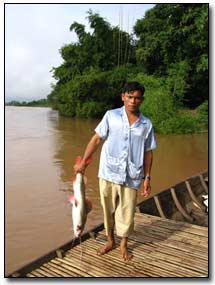 kayaks sponsored by feel free kayaks and arranged by Admotive Thailand making our expedition far more efficient. You guys rock!
kayaks sponsored by feel free kayaks and arranged by Admotive Thailand making our expedition far more efficient. You guys rock!
Over the following week we crept down the Mekong as it made a lengthy detour into Laos. The friendly smiles and welcoming nature of the locals we stayed with made the stretch even more memorable. Most of the people we met were fishermen and farmers, etching a subsistence way of life from the Mekong and the lushly forested mountains, which surround it. Along with Malaysia, Laos maintains the highest percentage of old growth forest cover in Asia at 40% of the land area. We surveyed as many locals as we could to gain a clearer understanding of their relationship with the river and its environments.
For most, fish caught in the Mekong made up the bulk of their families protein intake yet all noted with concern that catches had diminished significantly in recent years. Few understood the reasons behind the river not rising as it once did in the early months of the monsoon and none were aware e that this problem would continue to get steadily worse as further dams in China come on line. These subsistence farmers and fishermen will increasingly shoulder the cost of the Chinese economic boom and subsequent thirst for cheap electricity yet it appears that they will not share in the benefits.
We arrived at the former royal capital of Laos, Luang Prabang. With its unique history and its mixture of traditional Lao crossed with French colonial architecture the town has recently been awarded world heritage status. Gilded temples abound, as do great restaurants and a thriving night bizarre where ethnic minorities bring their wonderful handicrafts for sale. Despite becoming a relatively busy tourist destination Luang Prabang has to date managed to maintain the feel of a country town with a touch of royal elegance. We spent 3 days visiting waterfalls, temples and other historic sights before heading south.
I lost Brian and Hutch for a couple of days when the zodiac they were using had engine troubles and finally met them in the riverside capital of Laos, Vientiane. More of an oversized town than a city Vientiane provided the base from which we rested up and arranged various interviews and meetings for the documentary before again crossing into Thailand.
We were fortunate to arrive just in time to witness the candle festival in Nongkhai complete with
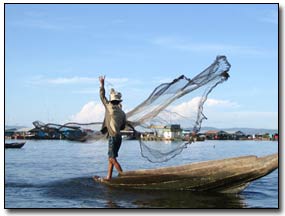 incredibly elaborate floats made almost entirely of bees wax; they really were works of art. We also
attended a small press conference where we met Thailand's most famous and intrepid paddler, Mr Rattapoom Youprom or "Thong" as he preferred to be called.
incredibly elaborate floats made almost entirely of bees wax; they really were works of art. We also
attended a small press conference where we met Thailand's most famous and intrepid paddler, Mr Rattapoom Youprom or "Thong" as he preferred to be called.
Thong had just finished his own amazing 3000 kilometer solo journey across the entire coastline of Thailand unsupported. As soon as he heard about a solo navigation of the Mekong River, Thong knew he had to come and join us for a while. The longer I knew Thong and the more his life story unfolded as we paddled south between Laos and Thailand the more I came to respect this incredible man.
Thongs expedition was inspired by a great need to come to peace with himself after a life altering experience shattered his world. Thongs mother and nephew were brutally murdered by a contract killer who hit the wrong targets and Thong discovered the aftermath. In a strange twist the assassin turned out to be a former childhood friend of Thongs who had turned to a life of drugs and crime. Thong was initially consumed with hate, pain and a desire for revenge and knew that these emotions would eat him up from inside and or lead to a life behind bars if he carried out his bitter plans.
His answer was to leave the world behind and take to the ocean in a bid to save his sanity and his soul. For 7 months he paddled unsupported along the Thai coastline living as a sea gypsy and in true Buddhist style lived off the generosity of local people who believe they gain merit for the next life through helping others on their quest for inner peace.
He is an amazing character. Today he is the epitome of a man at peace with himself. Friendly, at ease, patient and in love with life Thong has dealt with his demons and given up his previous goals of wealth and riches to focus on making the world a slightly nicer place in which to live. Thong is in the process of creating a "water" foundation in Thailand to dedicate resources to the conservation of the nations precious aquatic resources. Go Thong!
Thong was forced to leave us after just one week after a relative passed away and be bade him farewell at the border town of Nakhon Phanom. Along the way we started to hear more and more stories of an incredible phenomena that the locals call "Bung fai payanaak" or the Mekong fireballs. For reasons not fully understood, every year around the full moon of Buddhist lent, large luminous balls of light rise up out of the murky depths of the Mekong and float up into the atmosphere.
Personally I was very skeptical about the phenomena and simply put it down to folk law but I was intrigued enough to interview various people about what their experiences. I found that the event has been recorded by locals in the area for hundreds of years and I must admit that after interviewing dozens of locals and even some well respected foreigners who all claimed to have seen the phenomena first hand, I'm now a little more receptive to the concept. I'll be back next year to check them out for myself.
Not far from Nakhon Phanom the Mekong cuts eastward into Laos leaving Thailand behind and we made our way to the southern Lao capital of Pakse. It was here that we met a couple of interesting Belgians from UXO (Unexploded Ordinance) Lao. They were technical advisors to Lao staff who had the rather dubious job of picking up and disposing of the millions of unexploded bombs left over from US saturation bombing of Laos during the late 60's and early 70's.
Most people will be surprised to know that the most bombed country in the history of war fare is none other than Laos in South East Asia and what is worse is that of the millions of tons dropped, about 30%
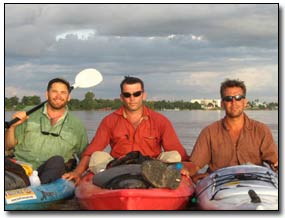 did not go off!!. As seems to be the case today, during the 60's and early 70's the US administration in Washington decided that if they killed lots of people in the third world that these people would change their view on the world and take to the American way of life. So without telling their own citizens the US government commenced saturation bombing of Laos that directly cost the lives of tens of thousands of Lao civilians. Of course all that killing of civilians had the affect of turning everyone against the foreign superpower and a s the communists were the only people fighting back, most of the Lao population abruptly joined the communist party even though many had no real communist ambitions. Hmm!! It all sounds a bit familiar doesn't it! One would hope the bureaucrats in Washington would have tried to learn something from this little episode in history. Recent events suggest not.
did not go off!!. As seems to be the case today, during the 60's and early 70's the US administration in Washington decided that if they killed lots of people in the third world that these people would change their view on the world and take to the American way of life. So without telling their own citizens the US government commenced saturation bombing of Laos that directly cost the lives of tens of thousands of Lao civilians. Of course all that killing of civilians had the affect of turning everyone against the foreign superpower and a s the communists were the only people fighting back, most of the Lao population abruptly joined the communist party even though many had no real communist ambitions. Hmm!! It all sounds a bit familiar doesn't it! One would hope the bureaucrats in Washington would have tried to learn something from this little episode in history. Recent events suggest not.
To all the UXO teams in Laos keep up the great work and we certainly hope that after another 150 - 200 years (conservative estimate) you can successfully clean up the mess that has been left in Laos by miss guided US foreign policy.
Finally we made it down to one of the most amazing parts of the Mekong called "the four thousand islands". At this point the Mekong braids out into various channels that make up a unique seasonal wetland habitat that can only be found in a select few places on earth such as the Amazon basin. Just before the river crosses into Cambodia at a breadth of 12 kilometers it tumbles off a fault line some 10 meters deep. The "Khone falls" are not as high as Niagara or Victoria falls in Africa but they do have more water tumbling off them making them an impressive sight at any time of year.
A favorite breeding ground for fish and hang out for the extremely rare Mekong Irrawaddy Dolphin, the falls are also home to some of the bravest fishermen on earth. We hung out with these fascinating men who risk their lives on a daily basis in and around the violent rapids to catch the sizable fish in the area.
The falls presented the last major navigational barrier for the Mekong First Descent Project. On previous paddle trips to the falls I had located and navigated various challenging class 5 runs down the fault line but with a tight schedule to keep and with people waiting for us just downstream in Cambodia I was forced to semi portage the locally famous "Liphi falls" (A central channel of the Khone Falls) after scouting two unviable channels and simply running out of time. This was particularly frustrating as I knew that if we only had a half a day or so available to scout alternative routes then I would definitely be able to run the drop as part of the Mekong descent but I guess it was not meant to be on this trip and at least it w as a section that I had previously run.
And so ended the middle Mekong section of the descent through Laos, Thailand and Myanmar. It would take weeks of writing to really go into all of the captivating moments which made the stretch so special but for now that can wait. It would suffice to say that the middle Mekong surpassed my expectations and inspired me in countless ways. It doesn't get better than this!
Thank you all so much for your support of the project and stay online for more updates soon.
Best Regards,
Mick O'Shea.
Read About The Complete Mekong Descent
| 
